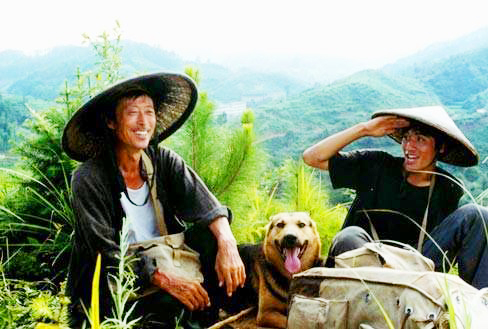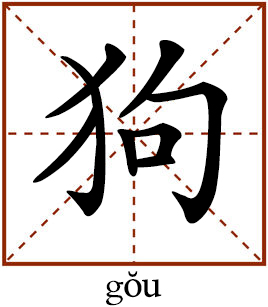Dog symbolism in the film Postmen in the Mountains

A scene in the film Postmen in the Mountains

Dogs are called gou and large ones were also called quan (犬) in the past. These two words are used interchangeably today. The word “犬” has become a component of scores of words related to animals and hunting, including wolf (狼), fox (狐狸), lion (狮), hunting (猎) and hunting in winter (狩).
Postmen in the Mountains, also known as That Mountain, That Man and That Dog is a classic Chinese film directed by Huo Jianqi.
The film tells the story of an old man who for years served as a postman for rural mountain communities, accompanied by an old dog. When he retires, he hands over the job to his son. He accompanies him on the first tour. Together, they deliver mail along a 115 kilometer long walking route which takes almost three days, into the rural heart of China and in the process the son learns about the father he never knew from the recipients of the mail.
The dog, named Lao’er, plays an important role in the movie, refracting Confucian values underlying Chinese society. Lao’er is a commonly used term in Chinese families to refer to the second child. This name indicates that the dog was treated as the younger brother of the son.
When embarking on his journey, the son called out “Lao’er, let’s go!” However, tail drooping, the dog moved toward the father. When the father decides to accompany the son, Lao’er runs ahead of them. Just like the father, Lao’er also needs time to learn about the son. Both father and the dog know little about the son because they spent most of their time on the road delivering mail.
According to the Confucian Classic and first Chinese dictionary Er Ya, “Doing well in serving one’s parents is called xiao, meaning filial piety; doing well in serving one’s elder brother is call ti, meaning fraternal love and respect. The delicate relationship between the father and the son mirrors the true situation in many Chinese families. Underneath the peaceful picture of a loving father and a son showing filial piety, the father’s absence in the son’s childhood life stands between them.
Lao’er serves to soften the father-son relationship during the journey. As the journey continues, Lao’er gradually learns about the son, changing his attitude of resistance. The son crosses the river while keeping the mail bag dry on his head. He carries his father on his back when crossing the river, protecting him from exposing injured knees to the cold water. Witnessing all these, Lao’er gradually learns more about the young son.
A close-up shows the father is moved to tears after opening his heart to his son. The Book of Rites says “What his parents love, one will also love; what they revere, he will also revere.” In the film, the actions of Lao’er follow this teaching. Lao’er shows his gratitude by picking up firewood with his mouth for the son to make a fire and warm up his cold body after wading across the river. Lao’er buries his head in the chest of the son resting on the wooden bridge. The son holds water with his hands, feeding his ‘younger brother.’ The intimate interaction between the son and the dog also symbolizes the easing of the estrangement between the father and the son.
When mail is blown away by the wind, the close-up of the panicked expression from the son, the rushing father and the galloping Lao’er trying to catch the mail is quickly edited together. At this very moment, the son finally understands the father’s humble life as a common postman. The father also realizes the debt of love that he owes to his son due to his absence in his son’s childhood.
A beautiful scene fitting the Confucian description of an ideal family forms at this moment: a father showing love to children and a son showing filial piety; an elder brother showing love to younger brothers and a younger brother showing respect to his elder brothers.
Liu Meiping is from the College of Literature and Journalism at Hunan University of Technology.
(edited by CHEN ALONG)
